Text
crit
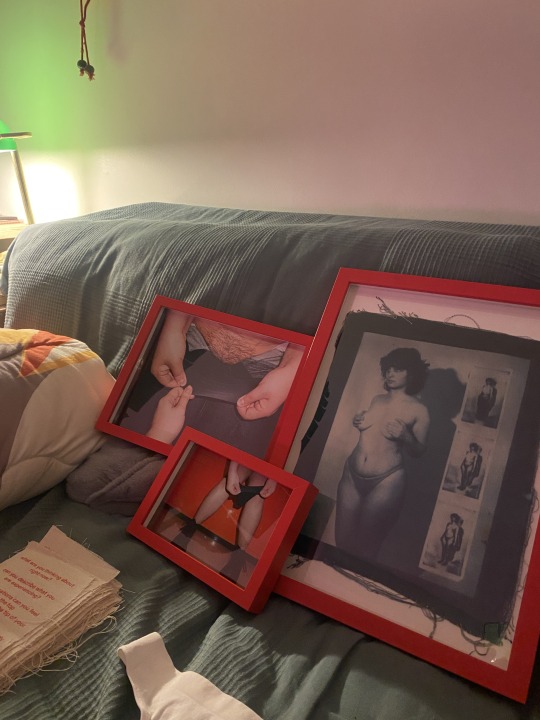
Laying out everything from the night before to make sure I had everything in front of me as there's a lot of moving parts.

I also made a really rough + messy sketch of the layout of the exhibition. I only had an hour to set everything up, so I had to be really decisive on where everything would go. I scouted 64 beforehand, so I knew the layout of it.
The setup went pretty smoothly, but I was sweating bullets. I ended up doing just about everything according to plan except for my 4D. When I was setting up the projector, it went through the wall onto the white paper. This brought me back to the crit where we talked about projection. I thought in an exhibition setting this would be perfect so on the fly, I modified the set-up to focus through the tulle and onto the back wall. I also ended up using the lights that were for the 4D recreation to light the pieces instead. This felt like a good morning because the video only worked like this with the lights off. Meaning everything else needed light. I thought seeing all the pieces finally come together played really well and reinforced each other. All are strong on their own, but putting them in the same space was impactful.
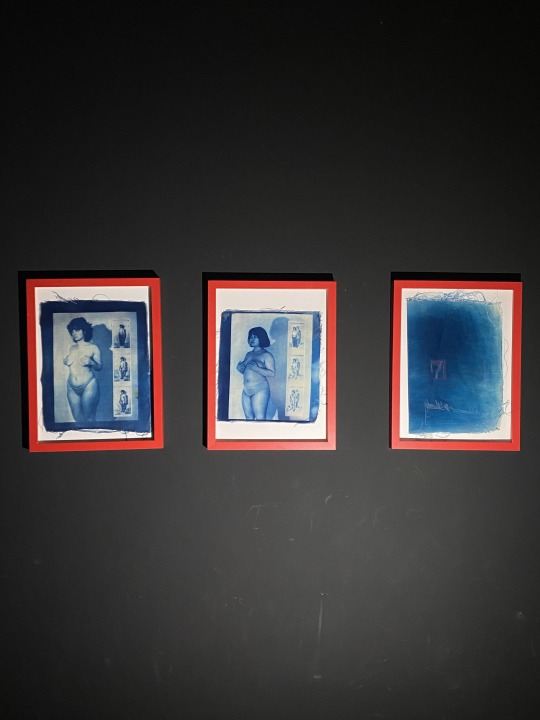

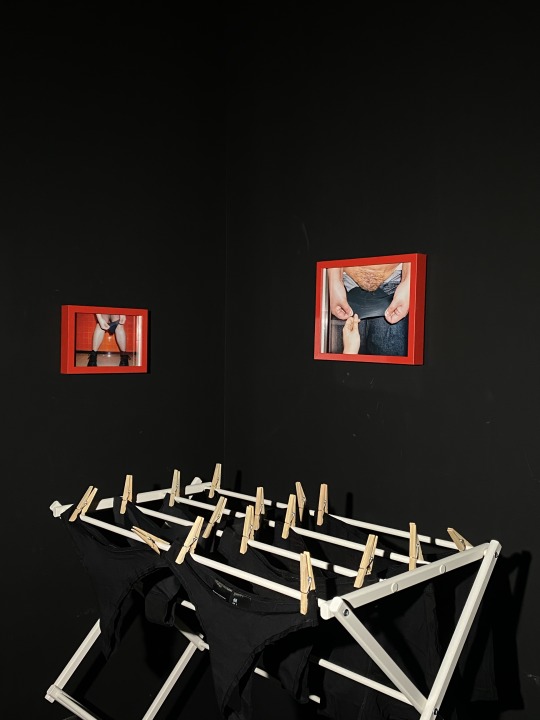
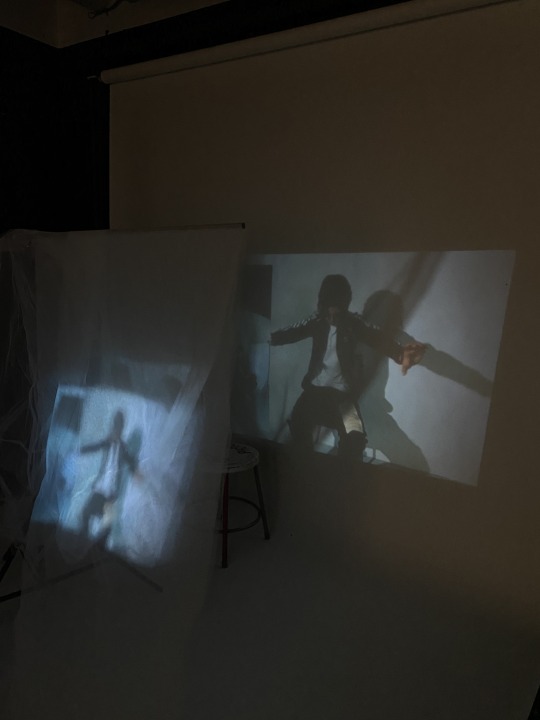
0 notes
Text
writing initiative 7
You have now had a chance to present your finalised body of work (2D, 3D, 4D, Reflective) to the class for feedback and discussion.
As we conclude the semester, please write a summary of your experience as a final blog post, including responses to the following:
What have you learned about yourself doing this self-directed assignment?
I learned that I really enjoy thinking about people and how people experience things and their perspectives. I am realizing through this project I really am obsessed with how people think and behave and what that means in conjunction with me. I also got to work through my own thoughts about things and got to think about the why of it all. Why do I think these things? Why do I feel these things. Being able to have the opportunity to reflect on that was rewarding. I also learned that talking with my peers really helped me out and gave me some things to think about further. I learned that I love screenprinting and printing on different materials.
What did you find to be the most difficult aspect of your chosen assignment? Creativity? Research? Connecting design to research? Craft? Organizational skills? Time management? Something else entirely?
Maybe iterating? I spent a lot of time thinking and researching. I actually really enjoy researching and it brings me joy but I wish I expanded more. Overall, I think iterating more in general was hard. Iterating in variety of research and iterating within the process. At the same time, within my thinking it made me feel more confident in the decisions I was putting forward. Sure maybe I could do better time management, but I really do think everything happened when it did for a reason.
What did you enjoy about this opportunity?
I really enjoyed getting to work so hands on and incorporating other creative things like textiles and photography into this body of work. I also enjoyed the deadline at the end, I didn’t feel like I had to make mid work just to appease the deadline and I can keep working hard on what feels right, including picking up things I thought I was finished. In that regard it was really interesting trying to make sure I had everything at the end.
How would you rate your performance over the course of the semester?
I would say that my performance went up exponentially over the course of the semester. I think the class as a whole had a hump to get over, me included. Post midterms and not working on the project during reading week gave me the opportunity to refresh and try again. I think I went above by not only making the pieces but doing my best to support the narrative in my body of work like supporting photos and installation. I also put a lot of work in craft and not doing the same outcome twice.
Hindsight is 20/20. What would you do differently, now that you've had this opportunity to work this way?
It’s difficult to say what I would do differently as I believe everything happens for a reason and rabbit holes of research follow suit. I would say maybe do more iterations for my reflective/more variety of things. But at the same time when I look back I also feel like I did a lot in the time that I had. Perhaps I wish I did some more research and expanded the horizons of this project. I also wish I took more time to synthesize my project more and take more time to write my manifesto at the end. I am somewhat satisfied with it but think it can go further.
1 note
·
View note
Text
reflective - final!

Borato: a thin piece of fabric
also: a facilitator for vulnerability
What is the smallest existence of a barrier that is required for vulnerability to be harboured?
A thin piece of fabric is performative in nature. It is a physical barrier that divides a space and separates us. While it exists as a separation, it’s malleable and lightweight; difficult to stand on its own. A thin piece of fabric is transparent, it can obscure but it can’t provide anonymity. You can feel through it, you can see through it. These are the characteristics of borato.
Barriers are key to lower insecurities and fears. The existence of a barrier soothes your mind as it embraces the separation of the self. There is a safety net in knowing your self perception, what feels like the true perception, is separated from everyone. The implementation of a barrier, no matter how performative, allows permission for vulnerability to pass through. It does not matter if this fabric can hear the sound of your voice, see your facial contours, or watch you walk. If it obscures or obfuscates to a minimal degree then it’s sufficient. This is how borato performs.
I believe as a photographer I am merely a facilitator and take a secondary role for these self breakthroughs in vulnerability to occur. Like a priest in a confessional, our roles are not necessary but our existence is a foundation for reflection and realization. Our role is to suspend all contexts from the outside world, the perceptions, and preconceived notions that you worry about others bearing onto you. You exist within the viewfinder and your life outside these pixels ceases to exist. For a moment you can simply be. Just as it’s not the priest who forgives, it is not the photographer who directs, we are intermediaries between you and your desired self. Vulnerability can initially be illusioned to please the intermediary. The yearning for recognition can only be relieved once the subject self-identifies with the intermediaries through mirroring and projection. Once you see yourself how I do, or welcome in another perspective, this vulnerability can thrive. Fear can live in the unknown, and by pulling back the curtain on the unknown to welcome the familiar, there is nothing more to hide.
Nudity and the body became a central theme to the project as it’s intertwined with my work. I have had this fascination towards the body and perception for a while now. It is the only thing you have for certain at life and at death that is truly you. Being naked is you in your rawest form, it’s one of the few constants that you can’t obscure. I do believe it’s a pretty Western view to ostracize nudity and find it uncomfortable or shocking. However, I wanted to use these notions to confront the audience about their own inhibitions about the body and nudity. Photographing the body is a perception shifter. A camera’s lens can work like fabric as it wraps and warps the body depending on your focal length. Angles, lights and shadows are all subtle barriers that add further distortion to the image. There is no singular perspective of your body and that should be embraced. Furthermore, I see the body just as is and try to move outside of external contexts as much as possible. We are anatomical and how lucky are we that we get to look like this?
As previously stated, my project aims to show a thin piece of fabric as a barrier. While applicable to any situation that involves trust, I found the dynamic between a photographer and subject to be delicate and personal. It’s a unique situation where this dynamic has a tangible outcome that is a direct result of a performative barrier. The works are a progression of attempting to thin out what is necessary for sensitivity to flourish. I was so infatuated with thinning out this barrier. So much so that as the project progressed, I tried to remove myself entirely. Going from a project that relies solely on my existence (2D) to an experience that relies entirely without (4D). Within this series of works you aren’t always getting the full image, and that’s okay. You don’t need to see everything to know that we got to that place of vulnerability. It’s for our eyes only.
INTERVIEW WITH CELINE
What were your thoughts before the shoot?
Before the shoot, I was a bit nervous about being nude, but it didn’t come from the prospect of others seeing the photos of me, or even about being on camera. I was much more concerned about the immediate moment, mostly about how awkward it might be in the studio. But I knew it was nothing I couldn’t handle.
What made you want to do this?
The main reason, really, was because I wanted to help you with the project. What are friends good for if not a couple naked photos? If I think about it for longer, it’s also because I think have this vision of myself in the future that I’m subconsciously trying to actualize. She lives life fully embodied. She’s ever-grateful and in complete awe of her body, a vessel that works and works hard. She has no reason to hide because she knows there’s nothing to see. It seemed like something she would do.
I noticed as we kept shooting that you were open to doing more, what changed in your thinking as the shoot progressed?
I mostly just started getting used to the feeling. But it also feels freeing to be so bare, like an undoing of how we are taught to be naked. That undoing was the change you were seeing.
Was there a moment during the shoot that was memorable to you?
When I first saw how I looked on the tiny screen of the camera, I remember being shocked at how I looked. Not to be that guy, but I totally thought I was more conventionally attractive. That first shock felt like an attack, it was like getting ambushed by an enemy that had been living in my home for years. She wasn’t doing anything wrong, it was just her body—unposed—and for a moment I felt like I was in danger. Feeling attractive feels like feeling strong, and this was like the all-too-late realization that I had been vulnerable this whole time.
This all happened so fast—and I could’ve definitely withdrawn then—but I just remember forcing myself to confront that girl. The impulse to judge so harshly upon seeing her body felt foreign, so unlike me. In every way, it contradicts the kindness and the gentleness that I worked so hard to cultivate in my mind. I forced myself to really look at her. And then I forced myself to feel her in my body. She is the body, the body that feels so strong right now. A masterclass on balance, shifting and changing in the ways it needs. And she looks like so many people I love. A certain level of disembodiment—of distance—is necessary in feeling that empathy for yourself.
INTERVIEW WITH CHLOE
What were your thoughts before the shoot?
When you first approached me for the shoot I was really interested in your concept. I remember seeing your past photography self portraits and thought they were so beautiful and unique so I was excited to see what you had in mind for this one. I really like how you capture the body in unconventional ways that sort of detaches it from the human that embodies it. It feels uncanny but in a good way. So when you asked if I was open to shooting semi-nude I was definitely interested, but honestly a bit nervous about being captured/seen in that way. I’ve never done anything like it before.
What made you want to do this?
First I always love helping out on shoots whether it’s behind or in front of the camera and I was excited at the prospect of creating with you! But also, I feel like on a personal note, the couple weeks leading up to the shoot I was experiencing some problems within myself and a close relationship that were really affecting my confidence. Agreeing to take part in the shoot felt like a reclamation and an opportunity to do something out of my comfort zone. I don’t get the opportunity to model for friends much, especially in such a raw, candid way. No makeup and no clothes felt like I was stripping myself of everything I present outwardly as my identity, so it felt really vulnerable. But I wanted this chance to feel vulnerable. In a weird way I thought it would help me process what I was experiencing in my personal life And in hindsight, it definitely did whether I realized it that day or not.
I noticed as we kept shooting that you were open to doing more, what changed in your thinking as the shoot progressed?
When I first agreed to semi nude, I was thinking like a bra and shorts or something. But once we started shooting and showing a little skin, I realized there really wasn’t anything to be scared of. First, the environment was super comfortable and open and I think you (and Celine) did a really amazing job at making me feel comfortable on an interpersonal level. Also, after you showed me some of the first shots, I was intrigued. I never saw myself in this manner, posed in this way; I felt like I wasn’t even looking at myself. I wanted to see more, and I wanted to further explore this weird feeling of perceiving myself not as myself. It was almost akin to an out of body experience, especially since I was already mentaly a little out of itthat day/week.
Was there a moment during the shoot that was memorable to you?
I really enjoyed the little receipt paper camera during the shoot. I think the immediacy of taking a shot and then seeing it was super memorable. I would feel a certain way posed, then immediately after see the image and feel a different sort of way. So just the back and forth between experiencing something in real time then immediately witnessing that from an external POV stuck in my head. I also really enjoyed being able to see how the shots you got of me fit in with the trio including yours and Celine’s portraits as well. I really admired seeing that come together.
How do you feel in front of a camera?
I have mixed feelings. I feel like actually, I just have mixed feelings about images of myself. In middle and high school before I became active on social media, images of myself were my primary method of self expression. I was really active in my painting/art practice at this time and produced a ridiculous amount of self portraits, all of which always felt (and still feel) very vulnerable. Then, I kind of transitioned into using a camera to take creative self portraits. Then, I started posting (non-creative) pictures of myself that I like on IG.
All of this is kind off the topic of the camera, but basically what I’m trying to get at is that I feel comfortable in front of a camera/with images of myself when I am the one in control; when I’m the one who controls what is seen and how it is seen. The second I give that power to someone else, I feel vulnerable and anxious. I am used to curating myself through image to an extreme, so allowing myself to be ‘seen’ by someone else’s lens is always a scary prospect. It’s not as much a discomfort with how I look, it’s a discomfort of the possibility of how I perceive myself not aligning with how someone else might perceive me. But honesty, as I’m maturing, I’m finding more comfort and intrigue in that notion. I think working on this shoot with you gave me a push to seek that discomfort even more—now I want to see how a different camera might capture me, whether it feels like me or not. I realize now there’s a beauty in seeing someone else’s vision come alive and live through you.
1 note
·
View note
Text
reflective - process
I separated the long form text into pieces that would fit on the screen and bought more muslin. I used muslin for the handout but I decided that the handouts don’t count towards the project so I purchased it again. The offwhite colour reminded me of aged paper used for scrolls. I did a test print by taping papers together and seeing how long it would get. I cut and steamed the fabric into a long strip and got it ready to be printed on. I printed it in 3 sections and did my best to line up the 3 sections by hand. Screenprinting with halftone images on fabric was difficult because of the need to find balance of pressure to not make the images bleed. For scale this is Warrick sitting next to the reflective piece.



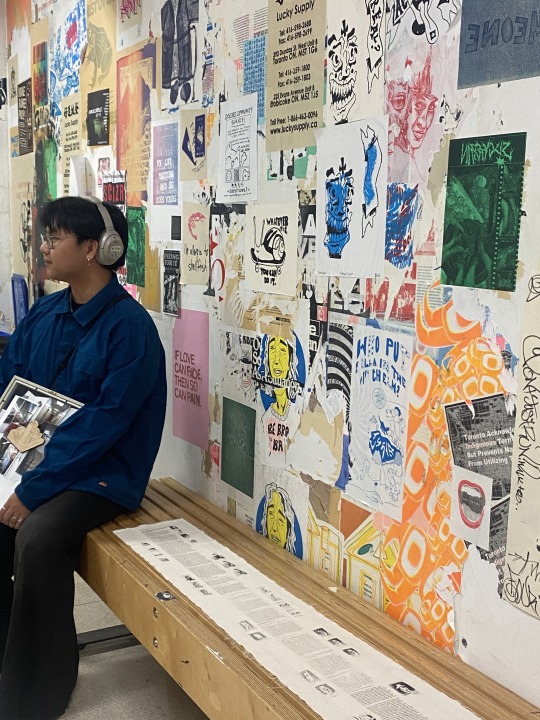

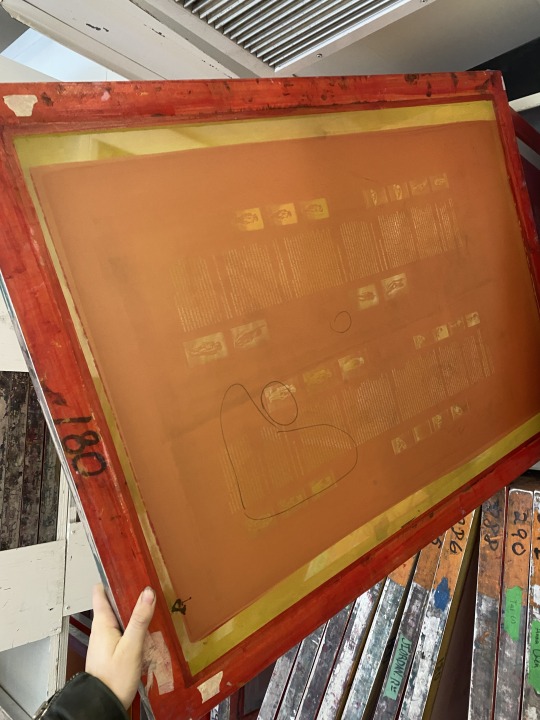

1 note
·
View note
Text
reflective - alternate idea
Before I had to expose I got nervous my idea wasn’t going to look good because I hated how it looked on screen. This was an alternative layout where the reflective would live more as a large tapestry with a collection of the strips on the front with a column layout on the back. It would live really big almost like a 20x27 inch thing. I scrapped this because the way someone would interact with it felt less borato than the initial idea. I decided to trust my main idea and hope that the format would elevate it.
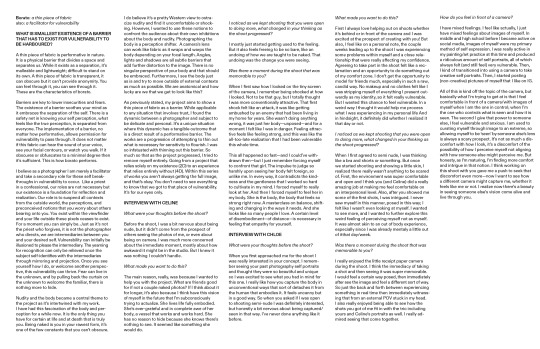
0 notes
Text
reflective - initial writing things
I drafted different writings, trying different structures like:
borato as performance
vulnerability and image
nudity
reflection
interview with celine
interview with chloe
This made sense initially because when I was writing I was jumping around at different topics, it helped to sort. Eventually, I scrapped it and blended the writing together. My first few drafts were pretty vague and circling around the topics. I refined it to be very overt about the definition of borato. Directly saying “this is how borato performs” and “these are the characteristics of borato”. If anyone was confused throughout looking at the different projects it would get straightened out by this point. I decided to only do black to separate this voice from the rest of the projects. Red is the voice of Gestalt (questions in red), blue is the voice of my subjects/people (the 4D video and cyanotype of everyone involved), therefore my voice and perspective needs to be different. I also thought that the black is plain and therefore you know that I’m talking to you straight up. I also decided on using these images because the camera acted as more of a behind the scenes + the film strip nature of it. I worked on it in sections of around 7x11 so it was easier to split up and expose on a screen.

0 notes
Text
reflective - interviews
CELINE
What were your thoughts before the shoot?
Before the shoot, I was a bit nervous about being nude, but it didn’t come from the prospect of others seeing the photos of me, or even about being on camera. I was much more concerned about the immediate moment, mostly about how awkward it might be in the studio. But I knew it was nothing I couldn’t handle.
What made you want to do this?
The main reason, really, was because I wanted to help you with the project. What are friends good for if not a couple naked photos? If I think about it for longer, it’s also because I think have this vision of myself in the future that I’m subconsciously trying to actualize. She lives life fully embodied. She’s ever-grateful and in complete awe of her body, a vessel that works and works hard. She has no reason to hide because she knows there’s nothing to see. It seemed like something she would do.
I noticed as we kept shooting that you were open to doing more, what changed in your thinking as the shoot progressed?
I mostly just started getting used to the feeling. But it also feels freeing to be so bare, like an undoing of how we are taught to be naked. That undoing was the change you were seeing.
Was there a moment during the shoot that was memorable to you?
When I first saw how I looked on the tiny screen of the camera, I remember being shocked at how I looked. Not to be that guy, but I totally thought I was more conventionally attractive. That first shock felt like an attack, it was like getting ambushed by an enemy that had been living in my home for years. She wasn’t doing anything wrong, it was just her body—unposed—and for a moment I felt like I was in danger. Feeling attractive feels like feeling strong, and this was like the all-too-late realization that I had been vulnerable this whole time.
This all happened so fast—and I could’ve withdrawn then—but I just remember forcing myself to confront that girl. The impulse to judge so harshly upon seeing her body felt foreign, so unlike me. In every way, it contradicts the kindness and the gentleness that I worked so hard to cultivate in my mind. I forced myself to really look at her. And then I forced myself to feel her in my body. She is the body, the body that feels so strong right now. A masterclass on balance, shifting and changing in the ways it needs. And she looks like so many people I love. A certain level of disembodiment—of distance—is necessary in feeling that empathy for yourself.
CHLOE
What were your thoughts before the shoot?
When you first approached me for the shoot I was really interested in your concept. I remember seeing your past photography self portraits and thought they were so beautiful and unique so I was excited to see what you had in mind for this one. I really like how you capture the body in unconventional ways that sort of detaches it from the human that embodies it. It feels uncanny but in a good way. So when you asked if I was open to shooting semi-nude I was definitely interested, but honestly a bit nervous about being captured/seen in that way. I’ve never done anything like it before.
What made you want to do this?
First I always love helping out on shoots whether it’s behind or in front of the camera and I was excited at the prospect of creating with you! But also, I feel like on a personal note, the couple weeks leading up to the shoot I was experiencing some problems within myself and a close relationship that were really affecting my confidence. Agreeing to take part in the shoot felt like a reclamation and an opportunity to do something out of my comfort zone. I don’t get the opportunity to model for friends much, especially in such a raw, candid way. No makeup and no clothes felt like I was stripping myself of everything I present outwardly as my identity, so it felt really vulnerable. But I wanted this chance to feel vulnerable. In a weird way I thought it would help me process what I was experiencing in my personal life And in hindsight, it definitely did whether I realized it that day or not.
I noticed as we kept shooting that you were open to doing more, what changed in your thinking as the shoot progressed?
When I first agreed to semi nude, I was thinking like a bra and shorts or something. But once we started shooting and showing a little skin, I realized there really wasn’t anything to be scared of. First, the environment was super comfortable and open and I think you (and Celine) did a really amazing job at making me feel comfortable on an interpersonal level. Also, after you showed me some of the first shots, I was intrigued. I never saw myself in this manner, posed in this way; I felt like I wasn’t even looking at myself. I wanted to see more, and I wanted to further explore this weird feeling of perceiving myself not as myself. It was almost akin to an out of body experience, especially since I was already mentally a little out of it that day/week.
Was there a moment during the shoot that was memorable to you?
I really enjoyed the little receipt paper camera during the shoot. I think the immediacy of taking a shot and then seeing it was super memorable. I would feel a certain way posed, then immediately after see the image and feel a different sort of way. So just the back and forth between experiencing something in real time then immediately witnessing that from an external POV stuck in my head. I also really enjoyed being able to see how the shots you got of me fit in with the trio including yours and Celine’s portraits as well. I really admired seeing that come together.
How do you feel in front of a camera?
I have mixed feelings. I feel like actually, I just have mixed feelings about images of myself. In middle and high school before I became active on social media, images of myself were my primary method of self expression. I was really active in my painting/art practice at this time and produced a ridiculous amount of self portraits, all of which always felt (and still feel) very vulnerable. Then, I kind of transitioned into using a camera to take creative self portraits. Then, I started posting (non-creative) pictures of myself that I like on Instagram.
All of this is kind off the topic of the camera, but basically what I’m trying to get at is that I feel comfortable in front of a camera/with images of myself when I am the one in control; when I’m the one who controls what is seen and how it is seen. The second I give that power to someone else, I feel vulnerable and anxious. I am used to curating myself through image to an extreme, so allowing myself to be ‘seen’ by someone else’s lens is always a scary prospect. It’s not as much a discomfort with how I look, it’s a discomfort of the possibility of how I perceive myself not aligning with how someone else might perceive me. But honesty, as I’m maturing, I’m finding more comfort and intrigue in that notion. I think working on this shoot with you gave me a push to seek that discomfort even more—now I want to see how a different camera might capture me, whether it feels like me or not. I realize now there’s a beauty in seeing someone else’s vision come alive and live through you.
0 notes
Text
reflective - second concept
For my second concept I knew I wanted a writing section and a section interviewing Chloe and Celine. As this project relies on multiple perspectives besides my own, I thought it was crucial to have both of our perspectives on the same reflective. It is as much their reflection as it is my own. I also wanted specifically Chloe and Celine as they were the starting point for borato so I thought it was an appropriate conclusion to the project. Additionally, I know I could’ve included the people from my 4D but I decided that the video makes you get to know them enough. Seeing someone recorded in a still image is mysterious and I thought the audience would get a kick out of hearing more about these people, especially Chloe who the audience never gets to see. I started writing about each of my projects, trying to make artist statements for each. It was primarily for the actual crit/exhibition but it served as an excellent jumping point into thinking about each project as a whole and really figuring out the goals with all of it.

I thought of different complex ways of laying out my reflective. However, it was tricky because I wanted to stand firm in not doing the same output method twice. I did cyanotype for 2D, clothes for 3D, and then tulle for 4D. Originally I was going to do iron on inkjet transfer sheets but I felt like it was too visually busy and wouldn’t blend in with the rest of my project. I also couldn’t get access to an inkjet printer. I decided a scroll would be performative and makes the most sense for reading long text. To print on a scroll I would need to screenprint.
0 notes
Text
reflective - scrapping that
I ended up scrapping this idea/not developing it further. I found it didn’t make sense to force my process as it’s ongoing to funnel into these 5 channels. It was bugging me because it’s not authentic to my process if I have to rebrand it to fit something else. I have come to realize if things start to feel complicated in my mind, it’s most likely the route to not go down. I was confused for a while on what a reflective means and what it means for my project. I felt that all my projects deeply blended in with itself and the dimensionality of it all that it felt weird to overtly call out my projects as projects because, well, they don’t necessarily feel that way. I wanted to find an alternative method that would pull back the curtains (pun intended) on the body of work but still reinforce this universe I created and built up. I was feeling very lost, even with looking at past years reflectives. I ended up finding inspiration during the 3rd to last crit hearing Sanchari read her reflective piece in full. Her writing perfectly reinforced her project as a whole without explicitly talking project to project about it. Bringing in some outside concepts + directly talking about the impacts.
0 notes
Text
reflective - gestalt
I initially split up everything about my process into following the layers of neurosis as I felt that it lined up pretty well with my feeling progressing during the semester. I had the most trouble with my 3D and it took the longest for me to come into acceptance with it. The layers of neurosis is a really important concept in gestalt psychology as it’s an extensive timeline for you to loosely follow along in your journey of authenticity. This lines up with my project as I feel that the goal in the end is really to achieve a balance of authenticity with myself and the work I put out.
THE PHONY
💡 this refers to the fake or inauthentic way that people act with other people. This can often be seen in the games that people play day to day (as Berne has written about in his TA approach) and the way people make small talk to avoid delving into anything too deep.
In the beginning, I felt the need to be performative, this can be stemmed back to when I selected my word. I picked this word knowing I would have to do grand gestures.
self imposed expectations of grand gestures
performative about my own ideas and how grand i felt they were
THE PHOBIC
💡 at this layer people resist seeing the real them. This includes aspects of oneself that might cause emotional disturbance or pain. As a result of this aspects of the real self are denied, and self-acceptance is forfeit.
To work through this I decided to be the most authentic in that moment and shoot myself
IMPASSE
💡 Feelings of emptiness or nothingness. This can also be accompanied by a feeling of being stuck, and an attitude of avoidance. People in this stage tend to try to manipulate the environment and people around them, rather than dealing with their problems. Perls’ thought this was an important layer, and saw it as the source of many problems in therapy.
This feeling of stuck and avoidance is the layer I’m at right now (March 2025). Pushing away working on my 3D because I don’t know what to do with it. I am working around everything to avoid working on my 3D meaning I am working on. I know I’m purposefully avoiding working on the inevitable and should definitely deal with it head on. I feel stuck and not progressing how I want to.
pushing away my 3d
needing more research
not liking what i have right now
IMPLOSIVE
💡 This layer occurs when a client allows themselves to come into contact with feelings they might have pushed away previously – feelings of deadness. This layer happens as a result of pushing through the previous layer, and the self that emerges is often seeking completion of some sort. One of the reasons this is sometimes referred to as the implosive layer is that important aspects of self are often pushed inwards or imploded, to keep them out of conscious awareness.
EXPLOSIVE
💡 This occurs when all the previous layers have been worked through. This is when the person often experiences catharsis, and this can be through grief, anger, joy and so on. This on it’s own isn’t enough though, and clients will need to continue onwards to make sure growth continues.
While I’m in this process of development to hopefully reach a cathartic feeling of a finale to this project, my work is endless and cyclical. Also following along with the therapy, I may not even be pleased by the end and that is okay and still means it could’ve been worked through
1 note
·
View note
Text
3d - final

To put everything together, I borrowed Alex’s drying rack and then bought clothespins from Dollarama. I thought this set up could live together in a corner and the two images could face each other, no matter what angle you’re looking at the set up you will be confronted with the images.
1 note
·
View note
Text
3d - photo printing + comparing

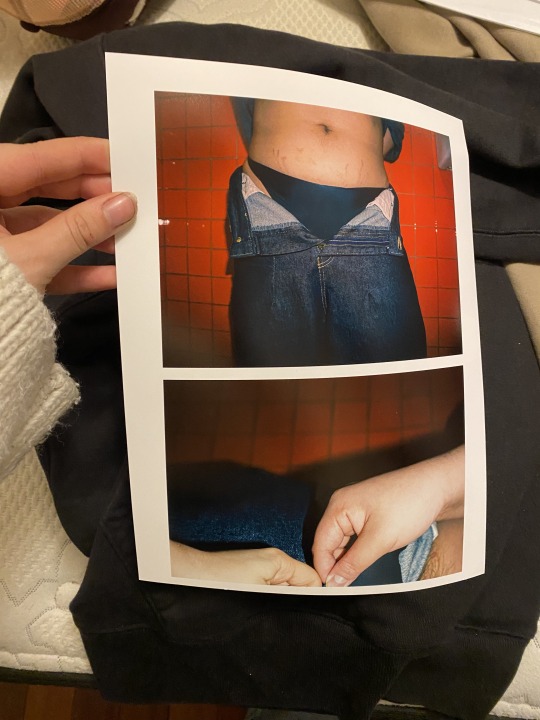
I also printed out on CMYK Inkjet from the printshop a strip of photos to use. I was originally only going to use these but then Alex recommended to use Epson printing as the colours will be more saturated

I printed out on Epson Premium Luster paper 8.5x11 in the photo floor 4th floor lab. To not waste paper, I printed out 2 5x7 images per page to not waste paper. I printed all the potential images and a couple extra of the preferred image. Just in case, I printed an 8x10 of the image I preferred more because I know I have an 8x10 frame on hand.
comparing

Comparing the two, I didn’t notice too much of a difference in all honesty. I thought both colours were pretty saturated and the quality was solid. I really couldn’t decide between which of the two finals I wanted to use so I decided to use both. I put the 8x10 print in the designated frame and then put the crouching one in the 5x7.
0 notes
Text
3d - photos
I want to have some photos to support the underwear. I have this vision of a small photo hanging on top of the underwear being displayed. I want to convey the shock that even I felt holding the underwear. I want it to be against the red tile, mid pulling the underwear down, using flash. All of these elements will invoke that shocking feeling. These attributes are all tools to total exposure. Strobe shows everything, red makes skin pop, the pose is jarring as well. I think the red would pair well with my exhibition since my frames are red. I want the photo to also act as a bit of a demonstration on how the underwear works.

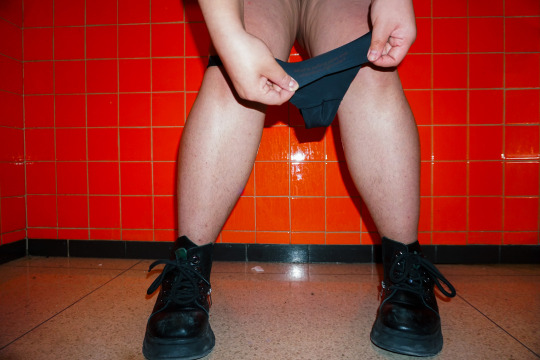





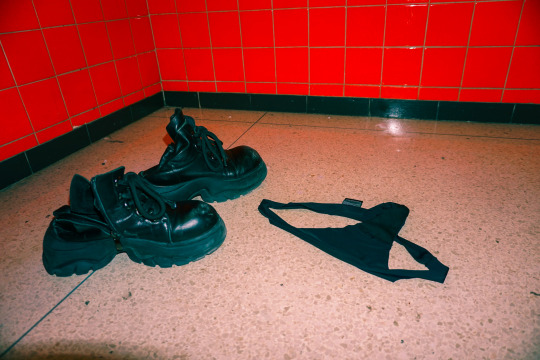
I really like both photos and will print both and decide between them. I think both are very strong because they follow all the criteria that I set and show how the underwear is supposed to work. I printed one out on plain draft bond and tested it in a frame. I really liked it and loved the contrast that the frame gives with the content.


0 notes
Text
writing initiative 6
Which piece did you present to the class today? How does it relate to the other pieces previously presented?
I presented the underwear today and a reformed plan to reshoot my 4D the way I really wanted it to. The underwear I did as a bit of a bit to get out of my system as I thought Gestalt on a thong was pretty funny. However, the more I sat with it in the crit, the more I liked it. It relates to my other pieces by using the Gestalt questions and being printed that way. My GD4 was related to my 2D by going the opposite spectrum from it. If my 2D relies on me then my 4D doesn’t need me.
2. Describe 2–3 specific strengths your classmates found in your work and their reasons for identifying them.
They felt that everything including what I presented today made sense and feels cohesive. Rachel gave me which I appreciated was that I clearly think about how people are going to interact with my work and it’s something I’m always considering. They also all generally liked the underwear and thought it was different and unique. There’s a shock value that I liked and I think my classmates liked it as well. Underwear feels shocking because it’s not normal and seeing it displayed so bluntly feels weird. I’m not sure if I’m going to change the underwear or not, I just need to figure out the rationale a bit more.
3. Describe 1–2 specific ways your classmates thought you could improve this work going forward.
My group suggested that the printing of the underwear should be on the inside as it’s personal and for you. I thought that was interesting and going to use that for sure. Vanessa also suggested that my underwear should be displayed on a drying rack which I thought was perfect. The drying rack keeps the mundaneness of the underwear but also invite interaction. These ways I wanted to follow.
4. Finally, you have now had a chance to present each of your projects (2D, 3D, 4D, Reflective) in process to the class. Produce an image of each one and describe how an aspect of your word is manifested in each piece.
2D

(not showing the actual photo in this one just because sorry)
This is borato because of the material it’s printed on. The aspect of a barrier before vulnerability is shown through the posing Celine is doing. The last layer of clothing and covering before total exposure. Also borato because of the thin canvas material being used. Borato in the way of vulnerability my models gave me and how that was a connecting moment between us.
3D

Borato because of the underwear being used; thin piece of fabric. Borato in vulnerability because of the text on it being from Gestalt questions.
4D

I have to reshoot but the idea of my 4D is to harbour vulnerability without me having to be there. It relates back to borato by thinning out the barrier socially and interpersonally. I’m unhappy with how poorly it was shot so I am redoing.
REFLECTIVE
I have no image of my reflective because it has not been made yet. I will say that my reflective will reflect borato because I’m going to print it on a long scroll. It will be a mix of a personal reflection and group reflection.
0 notes
Text
3d - printing part two

I bought fabric ink this time so it can actually be used and worn by people in the future. I also bought some black men’s underwear from H&M to be more inclusive of this theoretical experience for everyone. I flip flopped back and forth between doing inside or outside and ended up doing both. I also decided for the inside printing for it to face away from the user. This means that two people have to use the underwear for the questions be legible. The physical action of peeling the underwear and having to hold the waistband down to read held this thin barrier in frozen time. It forever holds the action of a final barrier being thinned out, just how a 3D project should be. I felt really pleased that I set out to try and freeze a moment of intimacy and I think I did.
0 notes
Text
3d - feedback
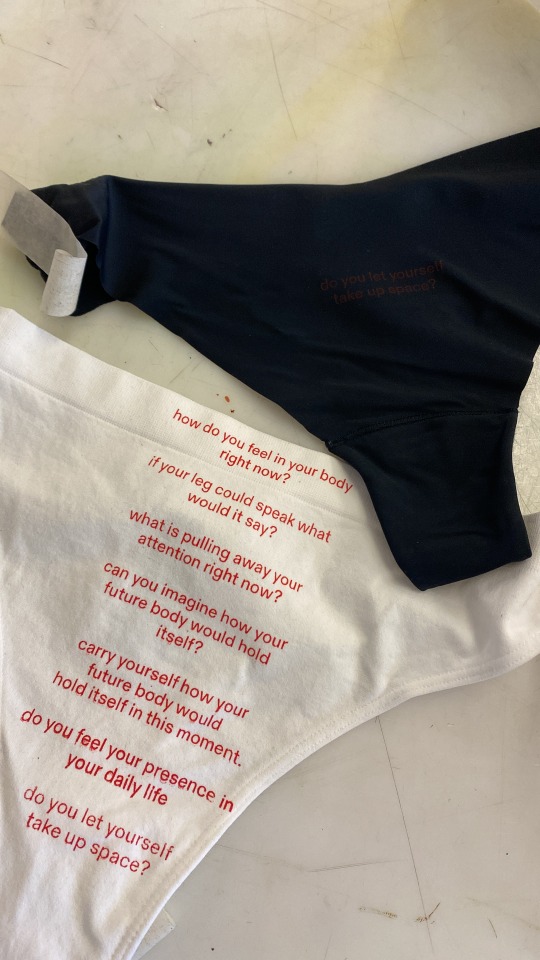
People were happily shocked with it, they liked how it made them feel. I was a little nervous showing them because it felt a little weird showing my classmates thongs. I also was nervous people thought it would stray too far from borato but everyone thought it made sense. They said I should do the red on black as the difficulty reading made more sense for the idea of thinning barriers. It’s really subtle and that is key for the 3D which I agree. They also said I should print it on the inside for it to be more for the user wearing it which was interesting.
0 notes